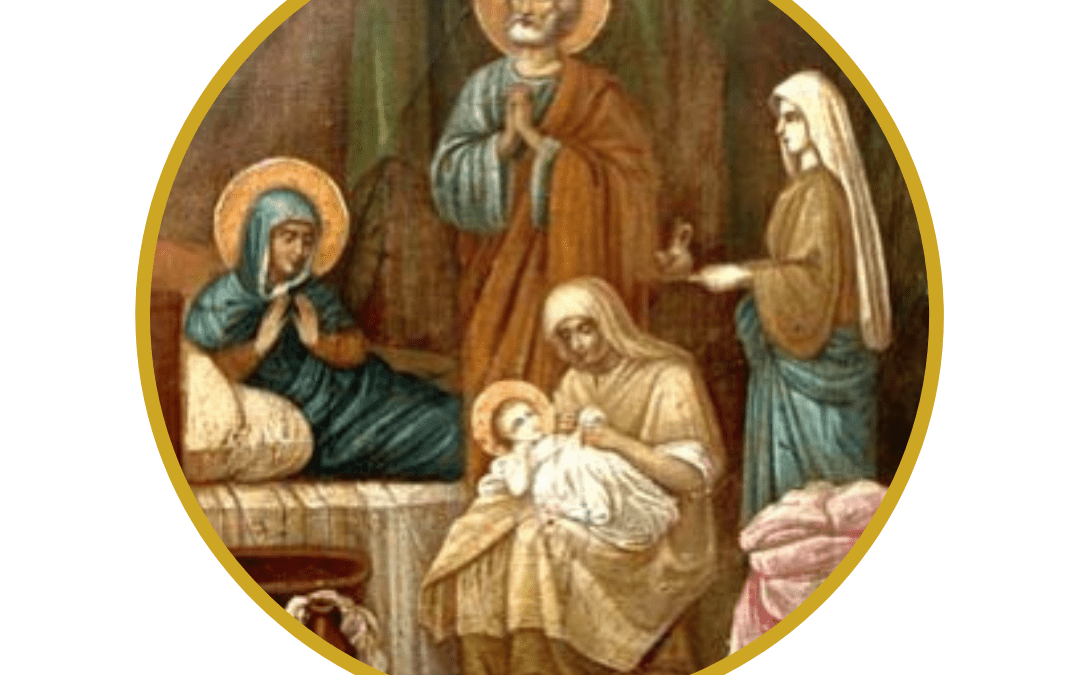8 September: Feast of the Nativity of the Blessed Virgin Mary. This feast day commemorates the birth day of Mary. There are only three birthdays on the liturgical calendar: Mary, Jesus, and John the Baptist. Usually, it is the custom to celebrate the feast day of a saint on the date of their death as that marks their “birth” into everlasting life. Mary, however, entered the world sinless (known as the “Immaculate Conception”). She was born to be the mother of the Savior of the world, the spiritual mother of all men, and the holiest of God’s creatures. Mary is called the firstborn of the redeemed and her nativity is “the hope of the entire world and the dawn of salvation” (Pope Paul VI, Marialis Cultus). Mary’s birth is not recorded in scripture but is found in the Protevangelium of James, an apocryphal writing from the 2nd century. The liturgical celebration of this feast has a joyous theme of light: the world that had been shadowed in the darkness of sin sees a glimmer of light with the arrival of Mary. Through Mary comes Christ, the Light of the World. The Blessed Virgin has a pivotal role in the history of salvation, and she was given the highest mission ever commended to any creature. We rejoice that the Mother of God is our Mother, too. Today and every day, let us often call upon the Blessed Virgin as “Cause of our joy”, one of the most beautiful titles in her litany.
There are some wonderful traditions from around the world that are associated with Our Lady’s birthday. Since September 8 marks the end of summer and beginning of fall, this day has many thanksgiving celebrations attached to it. In the older form of the Roman Ritual there is a blessing of the fall planting seeds. The winegrowers in France called this feast “Our Lady of the Grape Harvest.” The best grapes are brought to church to be blessed and then some bunches are attached to hands of the statue of Mary. A festive meal which includes the new grapes is part of this day. In the Alps section of Austria this day is “Drive-Down Day” during which cattle and sheep are led from their summer pastures in the slopes and brought to their winter quarters in the valleys. This was usually a large caravan, done with decorations and festivity. In some parts of Austria, milk from this day and all the leftover food are given to the poor in honor of Our Lady’s Nativity.
Ideas for celebrating this feast day:
- Have a birthday party for Mama Mary! Have children decorate the house with leftover party supplies in honor of their heavenly mother. Blue is the fitting color for this feast day (it is symbolic of Mary’s blue mantle).
- Ask children to think of a birthday “gift” they can give to Mary: a prayer; an act of mercy; a small sacrifice; a virtue to work on; a handful of wildflowers to adorn a Marian statue; etc.
- Make a blue and white cupcake rosary (a “rosary” made out of cupcakes, mini cupcakes, or cookies. Idea here. Sing “happy birthday” to Mary before enjoying this special dessert! A simple white cake symbolizing Mary’s purity is also perfect for this feast day.
- Eat “blue” foods, like blueberries, on this Marian feast day! Ideas: blueberry muffins or pancakes, blueberry pie, blueberry cobbler, or, simply, fresh blueberries.
- Consider purchasing a Marian statue for your home. Creating a Marian garden in your yard is another beautiful way to honor Our Lady.
- Learn and memorize prayers to Mary, such as: the Angelus, Litany of Loreto, Memorare, Hail Mary, and Hail Holy Queen.
- Learn a Marian hymn together as a family. Ideas: Regina Coeli, Ave Maria, Salve Regina, Immaculate Mary and Hail, Holy Queen.
- Find out about the devotion to “Maria Bambina” (“Baby Mary”)
- Read the papal encyclical Redemptoris Mater (Mother of the Redeemer) written by Saint John Paul II: Available here.
- Pray a rosary – that’s the best way to say “happy birthday” to your heavenly mother!
(sources: Excerpts from The Holyday Book by Fr. Francis Weiser, catholicculture.org, catholiccuisine.blogspot.com)

Recent Comments